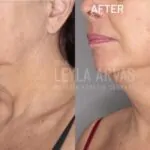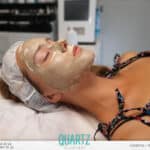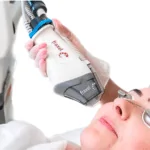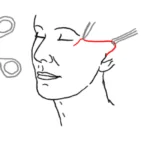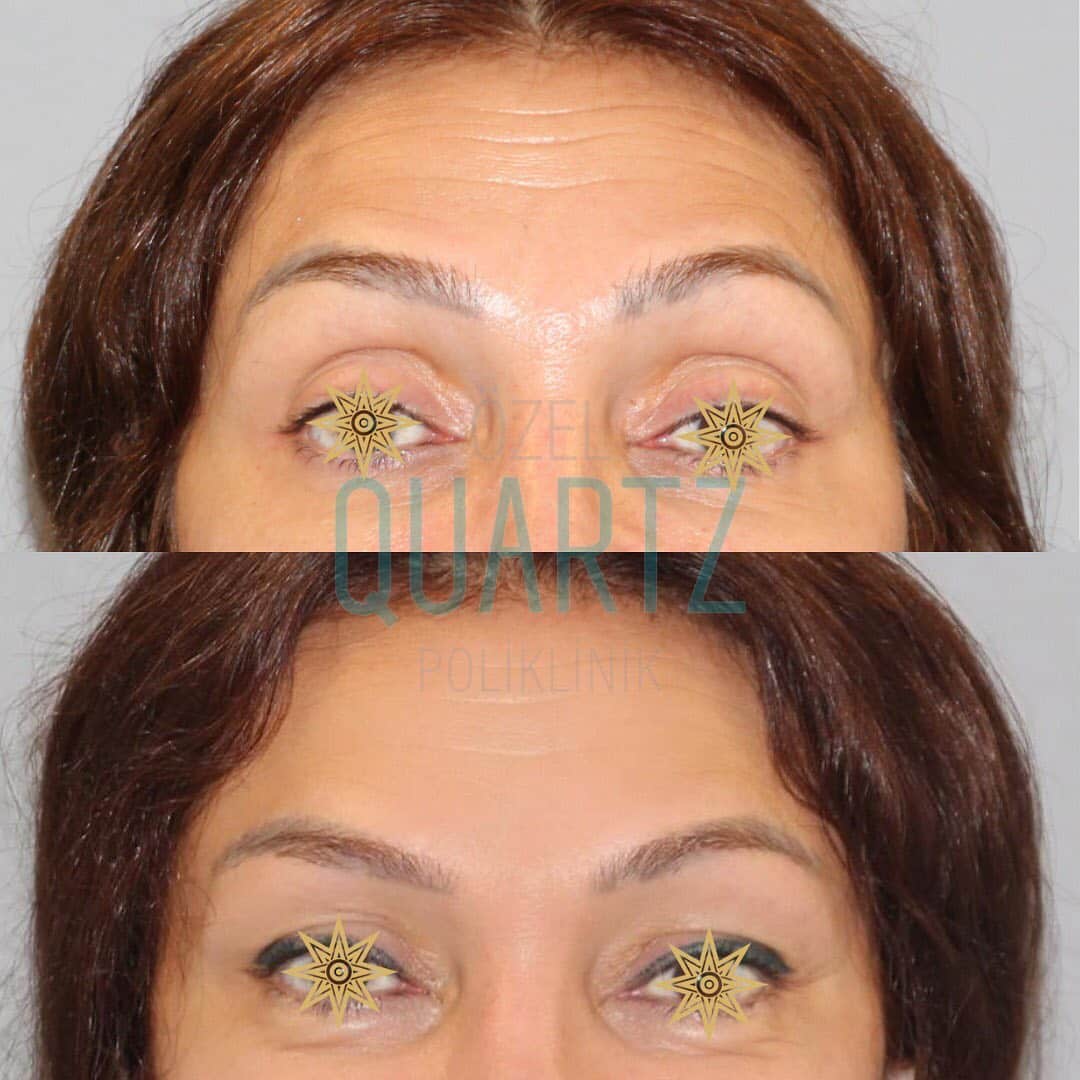
Botox and other injections can be used for liquid or injectable face lift procedures, brow lifts and fine line around the eyes. These non-surgical procedures are some of the most popular because they offer the same or similar benefits as the various surgical facelifts. Aside from the cosmetic benefits, Botox can help bring relief to those who suffer from chronic migraine headaches. Botox is the FDA-approved cosmetic treatment that is commonly used to stop aging lines and wrinkles on the face and neck and goose foot. It was applied to over 1 million people all around the world within the past 10 years.
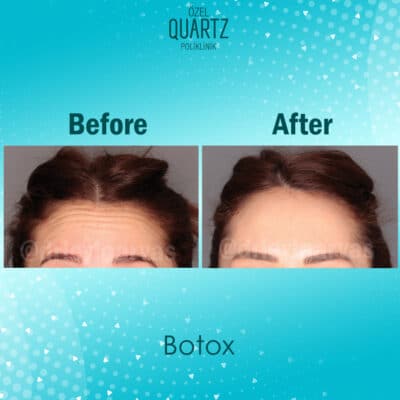 What Is Botox?
What Is Botox?
The way Botox injections work is to temporarily paralyze muscle activity in the treated area, and provide a dermal filler which fills out your lax skin. Botox injections are perfect to reduce the appearance of facial wrinkles and crow’s feet in adults.
It is the most popular aesthetic application in the world, and it is also used by those with excessive underarm, hand and feet sweating as well as patients with migraine.
Overactive muscles or overuse of certain muscles can result in wrinkles and fine lines. A chemical transmitter known as acetylcholine released in the nerve fibers is responsible for contraction of muscles. Botox injections work to block the nerves thereby preventing the release of acetylcholine. Instead of contracting, the muscles stay relaxed which means absence of wrinkles.
Botox is the trademark of a toxin produced by the bacterium Clostridium botulinum. An over application of Botox may cause paralysis. However, as a result of the recent research of scientists made the advantages of Botox useful as well. Small, diluted amounts may be injected into certain muscles in a way to ensure direct and controlled muscle relaxation.
When it was discovered in the late 1980s that Botox may cease such disorders as blepharospasm (involuntary quivering of eyelids) and amblyopia (lazy eye), FDA approved that use. Plastic surgeons have been using Botox for years in order to successfully treat wrinkles and facial wrinkles. Botox has been approved for treatment of frown lines, goose foot (lines around eyes) and under arm excessive sweating.
The Difference Between Botox and Fillers
While BOTOX and facial fillers fall into the same category of injectable cosmetic medication, they perform two separate functions. Understanding these differences, patients can be more educated regarding which product is right for them or if both are.
Botox and fillers are both used in cosmetic procedures, but they work in different ways. Botox is a type of purified protein that is injected into the muscles to temporarily relax them and reduce the appearance of wrinkles and fine lines.
Fillers, on the other hand, are injectable gels made of hyaluronic acid, collagen, or other materials that are used to add volume to the face and smooth out wrinkles and lines.With a base of naturally occurring hyaluronic acid, dermal fillers are designed to mimic the body’s native collagen layer beneath the skin. When injected precisely into certain areas of the face, facial fillers can reverse common signs of aging. These include drooping skin, fine lines and any other cosmetic issue caused by a loss of volume.
BOTOX is a muscle relaxer. It blocks nerve signals coming from the brain that tell a certain muscle to contract. In cosmetic medicine, BOTOX is used to prevent the contraction of wrinkle-causing muscles, primarily in the forehead. With a conservative use of BOTOX. Botox is typically used to treat dynamic wrinkles, which are caused by repetitive facial movements, fillers are more commonly used to treat static wrinkles, which are present even when the face is at rest. Botox also tends to last for a shorter period of time than fillers, typically around 3-4 months, while fillers can last up to a year or more depending on the type used and the area treated.
In some cases, a combination of Botox and fillers may be used to achieve optimal results in a cosmetic procedure. It is best to consult with a qualified and experienced practitioner to determine which treatment or combination of treatments is best suited for your specific needs and goals.
Where is Botox Used?
- Botox may be used not only for aesthetic purposes, but also for treatment methods. It may be used for
- Bending neck muscles and relaxing muscles,
- Lazy eye problem,
- Neurological cases,
- Treatment of excessive sweating,
- Chronic migraine patients,
- Urinary incontinence problem,
- Eye twitching,
- Removing wrinkles,
- Creating a lifting effect in skin.
How is Botox Applied?
Botox is typically injected using a small, fine needle into the targeted muscles. The procedure is usually quick and relatively painless, with most people experiencing only minor discomfort during the injection. The exact technique used for the injection may vary depending on the area being treated and the preferences of the injector. After the injection, it’s important to avoid rubbing or touching the treated area to prevent the spread of the toxin to other muscles.
When injected into facial lines, Botox product paralyzes the muscles in the application area and makes wrinkles less visible. Its effects are seen within a few days following the application and remain for 4-6 months.
Areas of using Botox became more varied over time. Headaches and neck pain, excessive sweating problem, migraine, facial spasms, muscular contradictions are some of the areas of use.
As a non-surgical procedure applied for removing mid-level and deep wrinkles, Botox is considered as a cosmetic product. The most important issue to be underlined for this operation is that the effect of Botox is not a permanent solution and mitigates over time. Extra operations may be required in the following periods. These lines can be removed in the early phase. Over time, lines become deep and Botox treatment cannot ensure sufficient removal alone, and some other additional treatments may be applied (laser, peeling, fill injection).
Who is Fit For Botox?
Botox is generally considered safe for most people who are in good health and have realistic expectations about the results. However, there are some people who may not be suitable candidates for the treatment. For example, Botox may not be recommended for pregnant or breastfeeding women, as the effects on a developing fetus or infant are not yet fully understood. Additionally, people with certain medical conditions or those taking certain medications may need to avoid Botox or discuss potential risks with their healthcare provider before undergoing the treatment.
- It can be applied to everyone between 18 and 65 for treating wrinkles in the face and neck. Its areas of use are as follows:
- Horizontal lines in the forehead,
- Lines between eyebrows,
- Lines around eyes,
- Lines around mouth,
- Lines in the neck.
How long do Botox injections last?
The effects of Botox injections typically last around three to six months, although this can vary depending on individual factors such as the amount of Botox used and the patient’s metabolism. As the effects of Botox wear off, the muscles will gradually regain their movement and wrinkles will begin to reappear. Patients can maintain the results of Botox injections by scheduling regular follow-up appointments with their provider and repeating the procedure as needed. It is important to follow all aftercare instructions provided by the provider to ensure the best possible results and minimize any potential side effects.
What is the best age to get Botox?
There is no specific age at which it is best to start getting Botox injections, as individual factors such as genetics and lifestyle can affect the development of wrinkles and fine lines on the face. However, many people choose to start getting Botox injections in their late twenties or early thirties, when the first signs of aging may begin to appear. By starting Botox injections at a younger age, patients can often achieve better results and maintain a more youthful appearance over time. Additionally, some younger patients may choose to get Botox injections for preventative purposes, as it may help to slow the development of wrinkles and fine lines in the long-term. It is important to consult with a qualified medical doctor to determine the best time to start getting Botox injections based on individual factors and goals.
Does Botox Have Any Risk?
Because this product is injected into the skin, there is a possibility of bruising and swelling at the injection site. This is a temporary and normal side effect, and it will resolve over time. The application of gentle pressure and the use of ice to the affected area after treatment can reduce bruising and swelling.
Additionally, Arnica gel and tablets are helpful. If bruising occurs, it may take up to two weeks to resolve. If needed, concealer can be applied on the day of treatment.
Other possible side effects include flu-like symptoms, drooping or heaviness of the eyebrow, headache, and drug interactions.
Severe side effects are rare and include allergic reactions, difficulty swallowing or breathing, and weakness over the body. Please call our office if you experience any of these reactions.
After Your Botox Recovery Process!
You will be able to return to your normal activities immediately following your Botox treatment. In most cases, there will be few telltale signs you just had a procedure done. In situations where mild bruising does occur, it can be covered up with makeup. If you have any soreness after the treatment, ice packs or cold compresses can be used to relieve the discomfort. Over-the-counter pain medications can also be used, although it is rarely necessary.
Botox injections are relatively safe, but side effects and complications can occur in some cases. These might include:
- Pain and bruising at the injection sites
- Skin redness
- Headaches
- Nausea
- Flu-like symptoms
- Temporary facial drooping “such as eye drooping
What not to do after Botox?
After getting Botox injections, there are several things that patients should avoid doing in order to ensure optimal results and reduce the risk of complications. Some of the most important things to avoid after Botox injections include:
- Touching or rubbing the injection site, as this can cause the Botox to spread to unintended areas.
- Engaging in strenuous exercise or other activities that could increase blood flow to the face, as this can also cause the Botox to spread.
- Consuming alcohol or taking blood-thinning medications for at least 24 hours after the procedure, as this can increase the risk of bruising and other complications.
- Applying heat to the injection site, such as with a sauna or hot tub, as this can also increase the risk of bruising and swelling.
- Lying down or reclining for at least four hours after the procedure, as this can also cause the Botox to spread to unintended areas.
It is important to follow your doctor’s specific instructions after getting Botox injections to ensure the best possible results and reduce the risk of complications.
When should you start getting Botox?
There is no specific age at which someone should start getting Botox injections, as everyone’s skin ages differently and at a different rate. However, many people begin to consider Botox as a preventative measure in their late 20s or early 30s, when fine lines and wrinkles may begin to appear.
Botox can be used to temporarily reduce the appearance of wrinkles and fine lines on the face, particularly around the eyes, forehead, and mouth. It can also be used to prevent the development of deeper wrinkles by relaxing the muscles that cause them to form.
The decision to start getting Botox injections should be based on individual factors, such as skin type, lifestyle, and personal preferences. It is important to consult with a qualified medical professional to discuss the potential risks and benefits of Botox injections and determine whether it is a suitable treatment option for your individual needs.
How long does Botox last?
The effects of Botox typically last between 3 to 6 months, but this can vary depending on individual factors such as the amount of Botox injected, the area of the face being treated, and the patient’s metabolism.
Over time, the muscles in the treated area will gradually regain their strength and the wrinkles or lines will begin to reappear. To maintain the results of Botox, patients will need to receive regular injections every few months.
It is important to note that the longevity of Botox results can also be affected by factors such as lifestyle, sun exposure, and smoking, so taking good care of your skin and overall health can help to prolong the effects of Botox injections.
What happens if you stop Botox?
If you stop receiving Botox injections, the muscles in the treated area will gradually regain their strength and the wrinkles or lines will begin to reappear. This process can take several weeks or months depending on the individual.
In some cases, the reappearance of wrinkles and lines after stopping Botox injections may be more noticeable than before treatment, as the muscles may have been weakened and relaxed by the injections over time.
It is important to note that stopping Botox injections does not have any long-term negative effects on the body or overall health. However, patients who have received regular Botox injections for an extended period of time may notice some changes in their facial appearance when they stop treatment. To maintain the results of Botox, patients will need to receive regular injections every few months.
How Much Does Botox Cost in Turkey?
The cost of Botox injections in Turkey can vary depending on several factors, such as the provider’s experience, the location, and the number of units required for the treatment.
It is important to note that while the cost of Botox injections in Turkey may be lower, it is still essential to choose a qualified and experienced provider who uses genuine Botox products to ensure the safety and effectiveness of the treatment. Patients should also consider other factors such as the provider’s reputation, qualifications, and overall patient satisfaction when choosing a Botox provider in Turkey.
For Turkish Ministry of Health-accredited centers, it is not legal to specify prices on their website. Therefore, please dial +90212 241 46 24 to contact our polyclinic and get information on our Botox prices.
What Are Botox Alternatives?
While Botox is a popular and effective treatment for reducing the appearance of wrinkles and fine lines, there are also alternative treatments available for those who prefer a non-invasive or less expensive option. Some common alternatives to Botox include:
- Dermal fillers: These injectable treatments use hyaluronic acid or other substances to add volume to the face and smooth out wrinkles.
- Chemical peels: This treatment involves the application of a chemical solution to the face to exfoliate and remove dead skin cells, improving the overall appearance and texture of the skin.
- Microdermabrasion: This treatment uses a device to exfoliate and remove dead skin cells, revealing smoother, more youthful-looking skin.
- Laser skin resurfacing: This treatment uses a laser to remove damaged skin cells and stimulate the growth of new, healthy skin cells.
- Facial exercises: Certain facial exercises can help tone and strengthen the muscles in the face, reducing the appearance of wrinkles and fine lines.
- Skincare products: Using high-quality skincare products that contain ingredients like retinol, vitamin C, and hyaluronic acid can also help reduce the appearance of wrinkles and fine lines.
It is important to note that while these alternative treatments can be effective, they may not provide the same dramatic results as Botox injections. It is best to consult with a qualified skincare doctor to determine which treatment option is best for your individual needs and goals.


